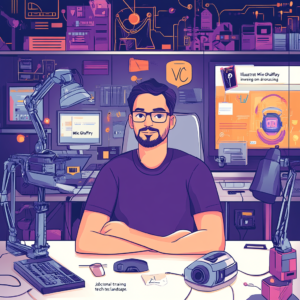
🔍🧠🎨🔬: Assessing Visual Cognition Limits in Multi-Modal Language Models
In the grand carnival of artificial intelligence, where algorithms dance and data pirouettes, one of the most compelling phenomena simmering in the background is the interplay between language and vision. As researchers dive headfirst into this intricate relationship, the emergence of large language models (LLMs) presents a tantalizing challenge: can these digital entities grasp the visual world like humans do? Recent studies have taken on this enigma with an engaging twist—psychology-based tasks that test the multi-modal visual cognition of these models. It sounds fascinating, doesn't it? So, let's get lost in the details.
Picture this: a team of bright minds from the Max Planck Institute for Biological Cybernetics, the Institute for Human-Centered AI at Helmholtz Munich, and the University of Tubingen have come together to scrutinize just how well these LLMs can navigate the twists and turns of visual information. Their work, published in the esteemed pages of Nature Machine Intelligence, aims to peel back the layers of these models to see if they can connect dots, understand relationships, and engage in what we would deem “human-like” visual reasoning.
What does it take to assess these dazzling cognitive faculties, you ask? The researchers fabricated a series of clever experiments akin to those found in traditional psychology studies. They pitted the LLMs against scenarios that mimic the complexities of our own understanding—one highlight was a test of intuitive physics, where the models were shown images of precariously stacked block towers and asked if these sights contained the essence of stability. If they didn’t answer correctly, we'd be forced to wonder whether they’re even remotely on the right track.
Next up, they tossed in some causal reasoning, where models were required to decipher relationships between events, and intuitive psychology, which tested their abilities to grasp the preferences and inclinations of other “agents.” Just as a chef combines spices to create a memorable dish, researchers blended these tasks to see how the LLMs would fare compared to human participants. It was an experiment akin to watching a toddler navigate a candy store for the first time—some delights were met with glee while others fell flat.
Unsurprisingly, the results revealed a mixed bag. While the multi-modal LLMs showcased some decent proficiency in handling basic visual data, they stubbed their toes on the complexity of nuanced human cognition. The models often missed the finesse that we humans perceive without a second thought. The researchers expressed a deep uncertainty: “At this point,” said Luca M. Schulze Buschoff and Elif Akata, co-authors of the scholarly work, “it is not clear whether this is something that can be solved by scale and more diversity in the training data.” The conversation veers into the broader landscape of inductive biases that these models may require—like front-row seats to a physics lecture on human worlds, they seem to need a basic processing engine to genuinely comprehend the physical reality around them.
Now, feeling a tad perplexed by LLMs’ limitations? Fear not! Researchers are cooking up solutions in the blazing cauldron of innovation. Enter the Cognitive Visual-Language Mapper (CVLM), and you can almost hear the triumphant trumpets heralding its birth. This fresh approach aims to enhance how LLMs align visual knowledge with textual descriptions, creating harmony that’s almost poetic in its execution. The CVLM is equipped with a Visual Knowledge Aligner (VKA) and a Fine-grained Knowledge Adapter (FKA)—the former translates visual knowledge into the language sphere of the LLMs, while the latter condenses and incorporates crucial visual insights into the models. This music of knowledge is designed to significantly amp up performance in visual question-answering tasks—envision it as an orchestra perfectly in tune.
As the researchers continue to unpack the intricacies of LLMs' capabilities, one thing becomes clear: fine-tuning these models on particular tasks can yield considerable improvements. However, even with ambitious innovation strategies like CVLM, obstacles abound. Questions of inaccurate knowledge representations loom over the horizon, alongside concerns that the length of distillation vectors might shake up model stability. The stakes are high, and the road to resolving these riddles is winding, filled with both trials and possibility.
Delving into the cognitive limits of multi-modal LLMs isn't just an academic endeavor; it's vital for sculpting AI systems that can better engage with the chaos of the human environment. Through studies like these, researchers illuminate the current progression of these models while offering a glimpse into a promising future rich with potential innovations.
As we closely observe the evolution of AI, we cannot help but wonder about the tantalizing conundrum these LLMs embody. They possess the dazzle and allure of a magician, yet at times, reveal the limitations of a novice performer. As research continues to unveil more nuanced layers of cognition, both for LLMs and ourselves, we stand at the edge of a thrilling new world, waiting for that next breakthrough.
In summary, the exploration of multi-modal LLMs through psychology-based tasks has unveiled a mosaic of insights into their visual cognition limits. While signs of progress are clear, these models remain behind the eight-ball when it comes to mastering the subtle intricacies of human cognition. But don’t lose heart; initiatives like CVLM and continued academic fervor could close that gap.
Are you hungry for the latest updates on neural networks and automation? Don’t miss out on the intellectual feast—subscribe to our Telegram channel: @channel_neirotoken. Dive deep into the world of AI and cognitive research with us, and let knowledge be your guide.

